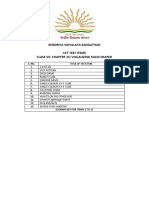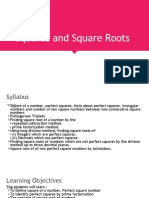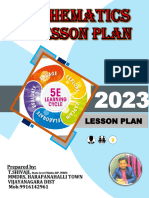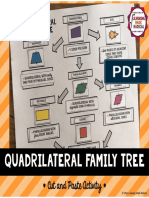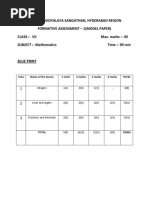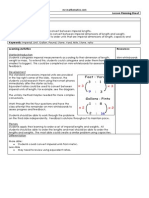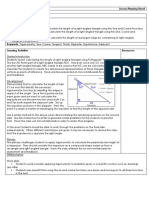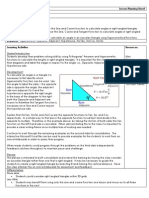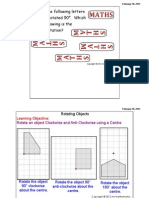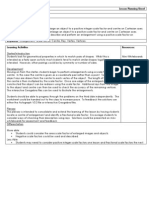Lesson Planning Sheet Title: Square and Cube Numbers Learning Objectives
Uploaded by
Jonathan RobinsonLesson Planning Sheet Title: Square and Cube Numbers Learning Objectives
Uploaded by
Jonathan RobinsonMr-mathematics.
com
Lesson Planning Sheet Title: Square and Cube Numbers Learning Objectives: By the end of the lesson: All students should be able to recognise the first 10 square numbers and 5 cube numbers. Most students should be able to calculate the first 15 square numbers and 6 cube numbers. Some students should be able to calculate any square or cube number and square root. Key words: Square Number, Cube Number, Power, Square root, Length, Area, Volume Learning Activities Starter/Introduction The activity on the first slide is intended to challenge the students to visualise different sized squares and triangles. If needed, work through identifying different sized triangles in the pyramid so that students are more able to attempt the 3 x 3 square. Encourage students to work together. Development It is important to relate square numbers to those that are the area of integer squares. Use the illustration of squares on the second slide for students to calculate (or count) the area of consecutive squares when given the length. Emphasise that it is the area, which is a square number. Have the students complete the table by looking for a pattern from the first six areas. When the table is completed discuss how the square root is a calculation to find the length of the square when given its area. Introduce the use of square and square roots using calculators to check the values in the table. Set the calculations in black for the students to work though. The third slide is similar to the second in teaching cube numbers as a volume. Plenary The final slide is used for the students to investigate solving problems with square and cube numbers rather than simply calculating with them. Pose the problems set and if needed guide the students to try different square and cube numbers. Discuss if zero is a cube and square number? Can a square have zero area or a cube have zero volume? Differentiation More able: Students could investigate triangle numbers. Student could consider the area/volume of a square/cube with an algebraic length. Less Able May need square/isometric paper to draw the shapes in order to count the area/volume. Students could stick to looking at only squares and cubes other than roots. Resources: Calculator Mini-Whiteboards
You might also like
- CBSE Class 6 Understanding Elementary Shapes Worksheet100% (1)CBSE Class 6 Understanding Elementary Shapes Worksheet1 page
- Class Viii - Chapter 15 - Visualizing Solid FiguresNo ratings yetClass Viii - Chapter 15 - Visualizing Solid Figures30 pages
- Updated Bridge Course Maths Class IX 2024-25No ratings yetUpdated Bridge Course Maths Class IX 2024-2511 pages
- CLASS 6 MATHEMATICS Bridge Course Primary (2024-25) (2)No ratings yetCLASS 6 MATHEMATICS Bridge Course Primary (2024-25) (2)82 pages
- Revision Assessment For Previous Knowledge Class 6 PDFNo ratings yetRevision Assessment For Previous Knowledge Class 6 PDF7 pages
- Daily Lesson Plan - Squares Square RootsNo ratings yetDaily Lesson Plan - Squares Square Roots5 pages
- Case_Study_Questions_Mensuration_Class_8No ratings yetCase_Study_Questions_Mensuration_Class_82 pages
- Math VIII PPT Introduction To Graphs S 1-6chandrika TyagiNo ratings yetMath VIII PPT Introduction To Graphs S 1-6chandrika Tyagi67 pages
- 7 Math Lab Activity 1 - Multiplication of Fractions100% (1)7 Math Lab Activity 1 - Multiplication of Fractions4 pages
- Scene Opens With Students Welcoming The Teacher in The ClassNo ratings yetScene Opens With Students Welcoming The Teacher in The Class5 pages
- CBSE Class 6 Mensuration Worksheet (2) - 3 PDFNo ratings yetCBSE Class 6 Mensuration Worksheet (2) - 3 PDF3 pages
- 8th MCQ Parallelograms and QuadrilateralsNo ratings yet8th MCQ Parallelograms and Quadrilaterals2 pages
- Quadrilateral Family Tree Cut and Paste ActivityNo ratings yetQuadrilateral Family Tree Cut and Paste Activity9 pages
- Real Life Examples of Parallelograms Include TablesNo ratings yetReal Life Examples of Parallelograms Include Tables1 page
- CBSE Test Paper 02 Chapter 13 Surface Area and VolumeNo ratings yetCBSE Test Paper 02 Chapter 13 Surface Area and Volume11 pages
- Class 7 Cbse Maths Sample Paper Term 1 Model 1No ratings yetClass 7 Cbse Maths Sample Paper Term 1 Model 12 pages
- Cbse Sample Papers For Class 7 Maths Fa4 PDF100% (1)Cbse Sample Papers For Class 7 Maths Fa4 PDF5 pages
- 10-Exponents and Powers Theory VIII MathsNo ratings yet10-Exponents and Powers Theory VIII Maths7 pages
- Amity International School, Gwalior: Class 7 Subject - MathNo ratings yetAmity International School, Gwalior: Class 7 Subject - Math12 pages
- Worksheet On Addition and Subtraction of IntegersNo ratings yetWorksheet On Addition and Subtraction of Integers2 pages
- 702788 Class Ix Mathematics Sem 2 Model Question Paper 2024 25No ratings yet702788 Class Ix Mathematics Sem 2 Model Question Paper 2024 258 pages
- Specification References: Statement Foundation 1.4No ratings yetSpecification References: Statement Foundation 1.44 pages






